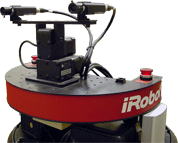
Overview

PA-10 portable general-purpose intelligent arm
The proposed robot manipulator will be used for experimental study, algorithms verification, and for research projects with applications in biomedical engineering and rehabilitation. The robot manipulator will provide an articulated robot arm with powerful, multitasking controller. Typical applications for the robot manipulator include machine loading, dispensing, polishing, cutting, drilling, trimming, and a wide range of industrial applications. The arm’s tool flange allows easy mounting of a variety of end effectors, including grippers, dispensers, or deburring tools. The controller features include a true multitasking operating system, a sophisticated trajectory planner, multiple digital inputs and outputs, relay outputs, serial ports, an emergency stop button, and support for an teach pendant.
Applications:
- Welding
- Grinding
- Plasma Cutting
- Attached to wall
- Component assembly
Current Arm Projects:
- Teleoperation of Surgical Robot
- Under Water Robot Simulation
- Web-based Arm Control
- Joystick Control of Robotic Arm
- Haptic Robotic Arm
Teleoperation of Surgical Robot

The mobile robot consists of a mobile base and an on board computer, and is equipped with a wide variety of sensors such as front sonar ring, rear sonar ring, bump ring, and surveillance/custom vision system. It has accessories such as a gripper, a joystick and a software plug-in. It has C/C++ compatible software libraries with built-in obstacle avoidance, sensor fusion, extensive mapping, and path planning behaviors and other navigational behaviors and tasks. The Ethernet makes it also the easiest platform robot in its class to interface with other devices, which means this open platform robot can be used to perform tasks such as real-time control of a very complicated robotics system through the application of Ethernet cards.
Applications:
- Path PlanningMap Building
- Rescue Robots
- Rang Sensing
- Nano Robotics
- Camera Callibration
- Humanoid robotics
- Legged Robotics
- Robot Vision
- Mobile Robot Control
- Senor Fusion
- Tele-robotics
- Collective Robotics
- Computational Intelligence
- Underwater Robotics
- Visual Serving
- Senor Networks
- Planning and Resoning
- Navigation
- Haptic Display
- Localization
- Robot Learning
Current Arm Projects:
- Sensor Fusion in Mobile Robotics
- Web-based Robot Control
- Mobile Robot Path Planning
- Voice Control Robot
- Computational Algorithm
- Developing
- Theory Study